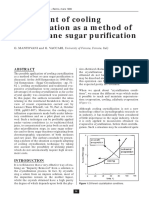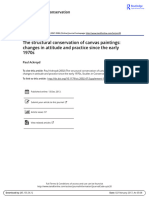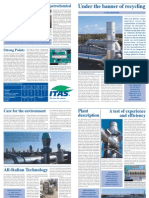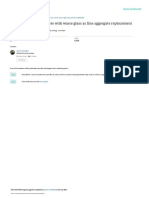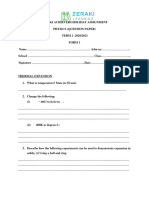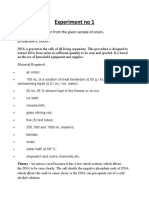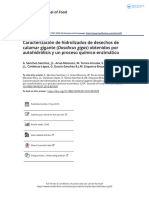Innovations Forum: U R G F A P C
Innovations Forum: U R G F A P C
Uploaded by
taramalik07Copyright:
Available Formats
Innovations Forum: U R G F A P C
Innovations Forum: U R G F A P C
Uploaded by
taramalik07Original Title
Copyright
Available Formats
Share this document
Did you find this document useful?
Is this content inappropriate?
Copyright:
Available Formats
Innovations Forum: U R G F A P C
Innovations Forum: U R G F A P C
Uploaded by
taramalik07Copyright:
Available Formats
INNOVATIONS FORUM
USE OF RECYCLED GLASS AND FLY #50 or finer, no expansion of the glascrete mortar bars was
observed. This means that the ASR expansion increases with
ASH FOR PRECAST CONCRETE increasing fineness of glass particles up to a certain point, and
then decreases afterwards [for details, see New York (1997,
1998)]. The practical implication of this finding is that waste
Postconsumer glass represents a major component of solid glass, ground to at least mesh size #100, is not likely to cause
waste. Because current collection methods are limited, only a unacceptable expansion due to ASR. However, for decorative
small fraction can be recycled directly to the primary market applications, it is desirable to include glass particles as large
— the bottling and container industry. The problem is partic-
Downloaded from ascelibrary.org by Western Sydney University Library on 10/30/19. Copyright ASCE. For personal use only; all rights reserved.
as mesh #4 in the concrete mix. In this case, the reactivity of
ularly acute in large metropolitan areas such as New York City, the large glass particles needs to be suppressed with appro-
which is collecting annually more than 100,000 tons of mixed- priate approaches.
color glass. This amount does not reflect the glass collected This new finding provides a sound experimental evidence
by industrial and commercial companies. On the other hand, for a comprehensive chemo-physico-mechanical theory, which
the United States generates 100 million tons of coal combus- is currently under development to rationalize the observed ex-
tion ash annually, of which 60 million tons are fly ash. Ap- perimental behavior. The ASR expansion process can be char-
proximately 27% of the fly ash produced is reused or recycled, acterized by using composite theories combined with diffusion
and the rest is landfilled. The purpose of the present research theories. Since ASR expansion is similar to thermal expansion
project is to develop two new materials called ‘‘glascrete’’ and of composite materials, the expansive strains can be deter-
‘‘ashcrete,’’ which have the potential of being made almost mined from theoretical models developed for thermal expan-
entirely out of recycled materials: crushed mix-color glass as sion of composites. One such theoretical model for evaluating
aggregate and activated fly ash (or portland cement) as ce- effective expansion of composites is based on the generalized
mentitious binder. Glascrete has an attractive appearance, self-consistent method, which was used in our study. As for
which makes it suitable for various architectural and decora- the ASR expansion mechanisms, the experimental evidence
tive applications. The combination of waste glass with port- suggests that there are two transport processes involved. One
land cement or activated fly ash offers intriguing possibilities, is the penetration of ions from the pore solution into the ag-
which will be highlighted in this paper. gregate, and the other is the permeation of the ASR gel formed
on the aggregate surface or interfacial transition zone into the
GLASCRETE: PORTLAND CEMENT CONCRETE
matrix. The ionic diffusion process is surface-area dependent.
WITH WASTE GLASS AS AGGREGATE
Thus, when the ion diffusion process is the predominant mech-
The first research phase dealt with the partial replacement anism, the expansion increases with increasing fineness of re-
of natural aggregate by waste glass in portland cement con- active aggregate. When the gel permeation is the predominant
crete. The main problem to be confronted was the chemical mechanism, the expansion decreases with decreasing size of
reaction between the alkali in the cement paste and the silica the reactive aggregate, because ASR gel formed around very
in the glass, called alkali-silica reaction (ASR). In ASR, the small aggregate particles can escape into the surrounding pores
hydroxide ions in the pore solution of the cement paste react of the cement paste with negligible resulting expansion. In
with reactive silica in the aggregate. The reaction products reality, the ASR expansion is the combined effect of these two
cause swelling and therefore can damage the concrete due to opposing transport processes, which can explain the pessimum
excessive cracking. An aggregate’s reactivity depends on the size effect.
crystal structure of its constituents. An unreactive aggregate
has ordered silica-oxygen tetrahedra, while a reactive aggre- Glass Type
gate (e.g., opal) has an amorphous structure, i.e., a disordered
network of silica-oxygen tetrahedra with large internal surface Since the chemistry of different types of consumer glass is
area and thus an unstable higher state of energy. Common different, one would expect different ASR expansions. Various
consumer glass is amorphous and therefore highly reactive in types of glass aggregate were tested, including soda-lime glass
portland cement concrete. Throughout the project, the accel- (used in most beverage containers), Pyrex glass, and fused
erated mortar bar test of ASTM C 1260 was used to examine silica. It was found that maximum expansions of mortar bars
the reactivity of glascrete. Our research showed that there are made with different glass aggregate types differ by almost one
several approaches that can effectively control the expansion order of magnitude. Window glass, plate glass, and windshield
of ASR due to glass aggregate, in addition to the conventional glass were found to cause negligible ASR expansion in the
approaches used to minimize ASR expansion of regular port- ASTM C 1260 test.
land cement concrete.
Glass Color
Size Effect
When studying the expansion of mortar bars containing
The particle size of glass aggregate was found to have a glass of different colors, clear glass (the most common kind
major influence on ASR expansion. Since the ASR reaction is in waste glass) was found to be most reactive, followed by
clearly a surface-area dependent phenomenon, one would ex- amber (brown) glass. Surprisingly, green glass caused no ex-
pect the ASR associated expansion to increase monotonically pansion. If ground fine enough, it even reduced the expansion
with aggregate fineness. However, there exists a size of the caused by the slightly reactive sand used in the mix. This
aggregate at which the maximum expansion occurs. This is means that finely ground green glass has the potential to be
called ‘‘pessimum’’ size, which for regular soda lime glass is an inexpensive ASR suppressant — a discovery for which Co-
about #16 or #30 mesh size. For aggregate finer than the pes- lumbia University has been granted a patent. The effectiveness
simum size, processes other than the surface-area dependent of green glass as an ASR suppressant was found to correlate
become predominant and the expansion decreases with further well with the amount of Cr2O3 that is added to the glass for
fineness. In fact, when waste glass was ground to mesh size color. Chromium oxide, added as a straight additive to the
JOURNAL OF MATERIALS IN CIVIL ENGINEERING / MAY 1999 / 89
J. Mater. Civ. Eng., 1999, 11(2): 89-90
concrete mix, increases the expansion considerable. But if ratio depends on the specific chemical composition of the ash
added as chemically bound frit, it can serve as an ASR inhib- to be used, particularly its Al2O3 and SiO2 contents. Tests with
itor. This ASR suppressing mechanisms of Cr2O3 has yet to be different water-to-binder ratios revealed the basic trend that
explained. The mortar bar test showed that the contributions the lower this ratio, the higher the resulting strength. The low-
of the various color components in mixed-color waste glass to est water-to-binder ratio tested was 0.3.
overall expansion do not follow linear superposition at all. In In order to evaluate the effectiveness of ashcrete in terms
fact, in the pessimum size range of #8 and #16 mesh particles, of reducing ASR-induced expansion, the same sand, coarse
mixed-color glass caused more expansion than clear glass, aggregate and glass aggregate were used as in the regular glas-
even though it contained sizable amounts of less reactive am- crete. The ashcrete mortar bar samples were tested by ASTM
ber glass and nonreactive green glass. These results require C 1260. As the first step, ashcrete samples were made with
further confirmation and scientific explanation. natural aggregate to compare it with normal portland cement
concrete. The expansions of the ashcrete samples were about
Downloaded from ascelibrary.org by Western Sydney University Library on 10/30/19. Copyright ASCE. For personal use only; all rights reserved.
Glass Content 0.017%, while those of portland cement samples were about
0.05%. These are small and unproblematic values, yet ashcrete
The ASR expansion of mortar bars as measured in the binder seems to reduce expansion of ASR. Not only is the
ASTM C 1260 test, was found to be almost linearly propor- maximum expansion of ashcrete much smaller than that of
tional to the percentage of glass in the mortar bar mix. These regular concrete, but the expansion time histories for ashcrete
results are in contrast to reports mentioned in the literature also exhibit different behavior. For portland cement concrete,
about the existence of a possible pessimum content of reactive the expansion increases continuously during the 14 day testing
aggregate. period. For ashcrete, all curves except the one for bars with
#50 glass particles showed that expansions increase for a cer-
ASHCRETE: ACTIVATED FLY ASH WITH tain period and thereafter decrease continuously. After about
GLASS AGGREGATE 10 days, the net expansions turned negative, i.e., instead of
expanding, the specimens shrank. For specimens with #100
In addition to the use of glass aggregate in portland cement glass particles, the shrinkage started after three days. The max-
concrete, the writers examined the effectiveness of a new con- imum amount of shrinkage measured was about 0.015%,
crete in terms of reducing ASR expansion. After briefly de- which is very small compared with the drying shrinkage of
scribing the properties of this new concrete, its effectiveness regular concrete.
in reducing ASR expansions will be discussed. Investigations similar to those described above for portland
The new material is called ashcrete. It is a low-cost and cement concrete with waste glass were also conducted for ash-
environmentally friendly cementitious material and has great crete to study the effect of glass particle size, glass type, color
potential for various applications in construction, especially for and content. The test results showed that (1) unlike in portland
precast concrete. Ashcrete consists of activation chemicals, cement concrete, green glass is not effective in suppressing
Class-F fly ash, coarse and fine aggregates without any port- ASR expansion; (2) ashcrete with Pyrex glass or fused silica
land cement. The utilization of fly ash is completely different as aggregated resulted in higher ASR expansion than if win-
from that in conventional concrete. Using ashcrete as a binder, dow glass aggregate was used; and (3) 100% of natural ag-
with waste glass added as aggregate, the resulting glascrete gregate can be replaced by waste glass, and the resulting ASR
could potentially consist of 100% recycled solid waste. expansion of ashcrete is below the limit of 0.1% considered
The controlling parameters of ashcrete have been identified by ASTM C 1260 as critical. The most important conclusion
and optimized in terms of strength development and cost. Ash- is that ASR-related expansion does not appear to be a problem
crete develops strengths up to 62 MPa (9,000 psi) in 24 h. for ashcrete with waste glass aggregate.
The activation chemicals are sodium hydroxide and sodium
silicate solution. There is no high calcium lime involved, and APPENDIX. REFERENCES
thus the nature of the chemical reactions is not pozzolanic, New York State Energy Research and Development Authority. (1997).
which results in a very fast strength development. The con- ‘‘Use of recycled glass for concrete masonry blocks.’’ Final Rep. 97-
trolling parameters that are particularly important for ashcrete 15, Nov.
New York State Energy Research and Development Authority. (1998).
have been identified, namely, the ratio of total activation chem- ‘‘Use of recycled glass and fly ash for precast concrete.’’ Final Rep.
icals to fly ash, the molar ratio of silica dioxide to sodium 98-18, Oct.
oxide (SiO2 /Na2O), and the water-to-binder ratio (binder is the
sum of sodium hydroxide, sodium silicate solution, and fly Christian Meyer
ash). The other controlling parameters are similar to those for Department of Civil Engineering
portland cement concrete, such as binder-to-aggregate ratio and Engineering Mechanics
and coarse-to-fine aggregate ratio. Columbia University
The ratio of the total activation chemicals to fly ash has an New York, NY
effect on both ultimate strength and strength development. The
basic trend is that the higher the ratio, the higher the resulting Yunping Xi
strength of the ashcrete. For economic reasons, the ratio should Department of Civil, Environmental
be kept below 20%. Also the molar ratio SiO2 /Na2O has a and Architectural Engineering
critical effect on both ultimate strength and strength develop- University of Colorado
ment. Our extensive test results showed that the SiO2 /Na2O Boulder, CO
90 / JOURNAL OF MATERIALS IN CIVIL ENGINEERING / MAY 1999
J. Mater. Civ. Eng., 1999, 11(2): 89-90
You might also like
- Experiment 1 Preparation of Buffer SolutionsDocument16 pagesExperiment 1 Preparation of Buffer Solutionsmohamad ashaziq90% (58)
- Bridging The Cost BarrierDocument5 pagesBridging The Cost Barriercklcat1437No ratings yet
- Absorption SymposiumDocument6 pagesAbsorption SymposiumLaudi FelisbinoNo ratings yet
- 1 Single Well ModelDocument8 pages1 Single Well ModelDominic angelNo ratings yet
- Cristalizacion EnfriamientoDocument9 pagesCristalizacion EnfriamientoHector Joel Chaname RodriguezNo ratings yet
- Flocculants and Coagulants NALCO (LIT) PDFDocument6 pagesFlocculants and Coagulants NALCO (LIT) PDFLily NurdianaNo ratings yet
- SPE-A Comprehensive Approach To Modeling Sanding During OilDocument7 pagesSPE-A Comprehensive Approach To Modeling Sanding During OilAndrés Eduardo Guzmán VelásquezNo ratings yet
- Separation Performance of Centrifugal CleanersDocument7 pagesSeparation Performance of Centrifugal CleanersGuru Prakash100% (1)
- Recycle PTQDocument6 pagesRecycle PTQremsorNo ratings yet
- Pintura de BaSO4 RefrigeranteDocument7 pagesPintura de BaSO4 RefrigeranteMaribel VazquezNo ratings yet
- Dhina 2005Document7 pagesDhina 2005Jeffrey JohnsonNo ratings yet
- Fines and Dust Generation and Control inDocument9 pagesFines and Dust Generation and Control inmedhanie tesfayNo ratings yet
- Zeosil - Dados TécnicosDocument9 pagesZeosil - Dados Técnicossamuk171No ratings yet
- 2002 - Fischer Et Al. - Latex Bead Projection Nanopatterns - Surface and Interface AnalysisDocument6 pages2002 - Fischer Et Al. - Latex Bead Projection Nanopatterns - Surface and Interface AnalysisClaudio BiaginiNo ratings yet
- Original Article in PDF Format (No Numbered Headings)Document13 pagesOriginal Article in PDF Format (No Numbered Headings)helena garcia riosNo ratings yet
- Rheological Properties of Microfine CemeDocument6 pagesRheological Properties of Microfine CemeROHAN DASNo ratings yet
- IonExchange Strengthening of Glassestomic Topology MattersDocument4 pagesIonExchange Strengthening of Glassestomic Topology MattersliangbaojiangNo ratings yet
- Particle Size Distribution For Refractory Castables - A ReviewDocument5 pagesParticle Size Distribution For Refractory Castables - A ReviewpetemberNo ratings yet
- Application of Hydraulic Fracturing Technologies, San AndresDocument10 pagesApplication of Hydraulic Fracturing Technologies, San AndresManav PatelNo ratings yet
- Okesanjo Et Al 2023 Effect of Shear On Pumped Capillary FoamsDocument9 pagesOkesanjo Et Al 2023 Effect of Shear On Pumped Capillary FoamsАлексей ЯковлевNo ratings yet
- Huayhua TesisDocument3 pagesHuayhua TesisFrank DiazNo ratings yet
- Remedial Cementing of Plugger PerforationsDocument7 pagesRemedial Cementing of Plugger PerforationsakilhidayatttNo ratings yet
- A Way To Control The Gold Nanocrystals Size UsingDocument8 pagesA Way To Control The Gold Nanocrystals Size UsingErrafi WissalNo ratings yet
- SPE28749 Arun PDFDocument8 pagesSPE28749 Arun PDFMuhammad Raynaldo PratamaNo ratings yet
- RTA AcetoneDocument8 pagesRTA AcetoneTiến TrươngNo ratings yet
- Li Et Al 2017 Experimental Study On The Strength of Original Samples of Wax Deposits From Pipelines in The FieldDocument10 pagesLi Et Al 2017 Experimental Study On The Strength of Original Samples of Wax Deposits From Pipelines in The FieldMarcos SilvaNo ratings yet
- Use of Membrane Collectors in Electrostatic PrecipitatorsDocument7 pagesUse of Membrane Collectors in Electrostatic PrecipitatorsStefanos DiamantisNo ratings yet
- Powder Processing Science and Technology For Increased Reliability PDFDocument13 pagesPowder Processing Science and Technology For Increased Reliability PDFfishvalNo ratings yet
- Spe 27342 MSDocument12 pagesSpe 27342 MSamin peyvandNo ratings yet
- Bacís Flotation Cell For Gold-And Silver-Beard Pyrite RecoveryDocument5 pagesBacís Flotation Cell For Gold-And Silver-Beard Pyrite Recoveryluis angel mendozaNo ratings yet
- Graphene Based Coating For CopperDocument9 pagesGraphene Based Coating For CopperAasiya ShaikhNo ratings yet
- FKR - Solvent - Free Deoiling of ParaffinDocument4 pagesFKR - Solvent - Free Deoiling of ParaffinNihar DongaraNo ratings yet
- RSC Advances: EditorialDocument2 pagesRSC Advances: Editorialdrakshaykumar.nanoNo ratings yet
- The Dispersion of CB in Rubber - Part I Rapid Method For Assessing Quality of DispersionDocument25 pagesThe Dispersion of CB in Rubber - Part I Rapid Method For Assessing Quality of DispersionFatima K. AlAbriNo ratings yet
- Miadata 15Document3 pagesMiadata 15Hamza LarnaoutNo ratings yet
- Acsami 1c02368Document8 pagesAcsami 1c02368Claudio SollarenNo ratings yet
- A Sand Production Prediction Model For Weak Sandstone Reservoir InkazakhstanDocument10 pagesA Sand Production Prediction Model For Weak Sandstone Reservoir InkazakhstanNguyenHopMinhNo ratings yet
- Study On Properties of Concrete Using Rice Husk Ash and Fly Ash As A Partial Replacement of Fine Aggregate and Cement With Sisal FiberDocument3 pagesStudy On Properties of Concrete Using Rice Husk Ash and Fly Ash As A Partial Replacement of Fine Aggregate and Cement With Sisal FiberEditor IJTSRDNo ratings yet
- Quartino Armor GBDocument2 pagesQuartino Armor GBitasmonzaNo ratings yet
- Tip Screenout Fracturing of Gas WellsDocument9 pagesTip Screenout Fracturing of Gas WellsOliver MontañoNo ratings yet
- Abdf - Novel ApplicationsDocument6 pagesAbdf - Novel ApplicationsVamsee KrishnaNo ratings yet
- Proper Regeneration of Molecular Sieves in TSA Processes-Part 1Document7 pagesProper Regeneration of Molecular Sieves in TSA Processes-Part 1G P100% (1)
- 界面 阵列减少热损失Document10 pages界面 阵列减少热损失mah71005No ratings yet
- Boosting Efficiency of Luminescent Solar Concentrators Using Ultra-Bright Carbon Dots With Large Stokes ShiftDocument12 pagesBoosting Efficiency of Luminescent Solar Concentrators Using Ultra-Bright Carbon Dots With Large Stokes ShiftTuhinNo ratings yet
- Full PDFDocument6 pagesFull PDFAtif KhanNo ratings yet
- SPE 100747 Expandable Sandface Completions-Design and Performance Review of Single-Zone Applications and Journey To Next-Generation Multizone SystemsDocument8 pagesSPE 100747 Expandable Sandface Completions-Design and Performance Review of Single-Zone Applications and Journey To Next-Generation Multizone SystemsyasamanNo ratings yet
- Acoustic Metamaterial Absorbers - The Path To Commercialization - 2023 - ReadDocument9 pagesAcoustic Metamaterial Absorbers - The Path To Commercialization - 2023 - Readzlora884No ratings yet
- Distribution Microporous A Functional: Pore Analysis Carbons: Density Theory ApproachDocument11 pagesDistribution Microporous A Functional: Pore Analysis Carbons: Density Theory ApproachBouzid MohamedNo ratings yet
- Sand Production Prediction Review - Developing An Integrated Approach PDFDocument12 pagesSand Production Prediction Review - Developing An Integrated Approach PDFRahul SarafNo ratings yet
- Api 67 121Document9 pagesApi 67 121Putra SyahrulNo ratings yet
- Building Glass Into The Circular Economy: How To GuideDocument8 pagesBuilding Glass Into The Circular Economy: How To GuideCarmízia Eugénia BernardoNo ratings yet
- NanotechnologyDocument6 pagesNanotechnologyns.diasNo ratings yet
- Radial Near Wellbore Stimulation by Acoustic Waves SPE 86492 MSDocument7 pagesRadial Near Wellbore Stimulation by Acoustic Waves SPE 86492 MSBolsec14No ratings yet
- Properties of Low-Density Cement-Bonded CompositeDocument11 pagesProperties of Low-Density Cement-Bonded Compositepathan yasinNo ratings yet
- Zrwithout ZRDocument9 pagesZrwithout ZRPhạm CườngNo ratings yet
- Influence of LDEDocument7 pagesInfluence of LDEDaniel BorobioNo ratings yet
- Recycling of Seashell Waste in Concrete: A Review: Construction and Building Materials February 2018Document15 pagesRecycling of Seashell Waste in Concrete: A Review: Construction and Building Materials February 2018Khusnul khotimahNo ratings yet
- SHAYAN 2004 Value Added Utilisation of Waste Glass in ConcreteDocument9 pagesSHAYAN 2004 Value Added Utilisation of Waste Glass in ConcreteWalid BouroudiNo ratings yet
- Studies of Sedimentation Basin DesignDocument15 pagesStudies of Sedimentation Basin Design305773253No ratings yet
- Recycling of Seashell Waste in Concrete: A Review: Construction and Building Materials February 2018Document15 pagesRecycling of Seashell Waste in Concrete: A Review: Construction and Building Materials February 2018Jay-Ar S. SungaNo ratings yet
- PCIJ Submission Guidelines - Sept20Document4 pagesPCIJ Submission Guidelines - Sept20taramalik07No ratings yet
- Effectiveness of New Silica Fume Alkali Activator: Vladimı R Z IvicaDocument5 pagesEffectiveness of New Silica Fume Alkali Activator: Vladimı R Z Ivicataramalik07No ratings yet
- Zoology Lecturer Solved Mcqs 2004Document12 pagesZoology Lecturer Solved Mcqs 2004taramalik07No ratings yet
- Standard Practice For Polyurethane Raw Materials - Polyurethane Foam Cup TestDocument5 pagesStandard Practice For Polyurethane Raw Materials - Polyurethane Foam Cup Testtaramalik07No ratings yet
- Cement and Concrete Composites: Jian-Xin Lu, Zhen-Hua Duan, Chi Sun PoonDocument11 pagesCement and Concrete Composites: Jian-Xin Lu, Zhen-Hua Duan, Chi Sun Poontaramalik07No ratings yet
- Cement & Concrete Composites: Rachel Redden, Narayanan NeithalathDocument11 pagesCement & Concrete Composites: Rachel Redden, Narayanan Neithalathtaramalik07No ratings yet
- Effect of Curing Period Rest Period and MixproportDocument5 pagesEffect of Curing Period Rest Period and Mixproporttaramalik07No ratings yet
- Residual Compressive and Flexural Strength of A Recycled Aggregate Concrete Following Elevated TemperaturesDocument8 pagesResidual Compressive and Flexural Strength of A Recycled Aggregate Concrete Following Elevated Temperaturestaramalik07No ratings yet
- Behavior of Recycled Construction Material Concrete Against Elevated TemperaturesDocument9 pagesBehavior of Recycled Construction Material Concrete Against Elevated Temperaturestaramalik07No ratings yet
- Effect of Elevated Temperature On The Compressive Strength of Recycled Aggregate ConcreteDocument5 pagesEffect of Elevated Temperature On The Compressive Strength of Recycled Aggregate Concretetaramalik07No ratings yet
- Waste Management of Debris To Durable Block Using Rca and Fly ASHDocument10 pagesWaste Management of Debris To Durable Block Using Rca and Fly ASHtaramalik07No ratings yet
- Characteristics of Concrete With Waste Glass As Fine Aggregate ReplacementDocument8 pagesCharacteristics of Concrete With Waste Glass As Fine Aggregate Replacementtaramalik07No ratings yet
- Mechanical Properties of Concrete Containing Recycled Concrete Aggregates Subjected To Different Fire DurationsDocument15 pagesMechanical Properties of Concrete Containing Recycled Concrete Aggregates Subjected To Different Fire Durationstaramalik07No ratings yet
- Effects of Waste Plastic in Concrete: March 2019Document7 pagesEffects of Waste Plastic in Concrete: March 2019taramalik07No ratings yet
- Hall Et Al-2019-Insect ScienceDocument15 pagesHall Et Al-2019-Insect Sciencetaramalik07No ratings yet
- Fire Resistance of y Ash-Based Geopolymer Concrete Blended With Calcium Aluminate CementDocument12 pagesFire Resistance of y Ash-Based Geopolymer Concrete Blended With Calcium Aluminate Cementtaramalik07No ratings yet
- Reuse of Waste Glass As A Supplementary Binder and Aggregate For Sustainable Cement-Based Construction Materials-A ReviewDocument71 pagesReuse of Waste Glass As A Supplementary Binder and Aggregate For Sustainable Cement-Based Construction Materials-A Reviewtaramalik07No ratings yet
- Resources, Conservation & Recycling: Yiwei Liu, Caijun Shi, Zuhua Zhang, Ning Li TDocument13 pagesResources, Conservation & Recycling: Yiwei Liu, Caijun Shi, Zuhua Zhang, Ning Li Ttaramalik07No ratings yet
- TTT DiagramDocument6 pagesTTT DiagramMahfoudh TALEB ALINo ratings yet
- Science Mastery Test SyllabusDocument3 pagesScience Mastery Test SyllabusShahid Imran AasiNo ratings yet
- Legure Bakra - BronzeDocument25 pagesLegure Bakra - BronzespahicdaniloNo ratings yet
- Subject ChemistryDocument13 pagesSubject ChemistryNikita JakharNo ratings yet
- Zeraki Achievers Term 2 AssignmentDocument9 pagesZeraki Achievers Term 2 AssignmentLucas makokhaNo ratings yet
- Unit Test-3 Class 10Document4 pagesUnit Test-3 Class 10Akshaya sriNo ratings yet
- Cjce 22656Document6 pagesCjce 22656Tua HalomoanNo ratings yet
- Arenes Reactions ch12 2022 UpdatedDocument164 pagesArenes Reactions ch12 2022 UpdatedNizarNo ratings yet
- CoA Povidone K30 SDocument2 pagesCoA Povidone K30 SDheyne TellesNo ratings yet
- Medium: Fluid: Accuracy: MaterialsDocument3 pagesMedium: Fluid: Accuracy: MaterialsSakshi SharmaNo ratings yet
- Jurnal Internasional Tentang Sifat Koligatif Larutan PDFDocument3 pagesJurnal Internasional Tentang Sifat Koligatif Larutan PDFNelly DwiNo ratings yet
- Water Resistant Coating FormulationDocument6 pagesWater Resistant Coating FormulationPamela VillanuevaNo ratings yet
- Experiment No 1: DNA Extraction From The Given Sample of OnionDocument27 pagesExperiment No 1: DNA Extraction From The Given Sample of OnionHimanshuTripathiNo ratings yet
- SPE 2198 Analysis and Prediction of Minimum Flow Rate For The Continuous Removal of Liquids From Gas WellsDocument8 pagesSPE 2198 Analysis and Prediction of Minimum Flow Rate For The Continuous Removal of Liquids From Gas WellsGustavoMillaNo ratings yet
- IPS - Block Cheese - ENDocument2 pagesIPS - Block Cheese - ENTarik ConceptNo ratings yet
- Clariant Brochure Personal Care Preservatives 2019 ENDocument12 pagesClariant Brochure Personal Care Preservatives 2019 ENAmandla XokiNo ratings yet
- C04-S02 Rev 2 Dec 2014 Construction of Asphaltic Conc. Paving N RoadwaysDocument20 pagesC04-S02 Rev 2 Dec 2014 Construction of Asphaltic Conc. Paving N Roadwaysryann mananquilNo ratings yet
- Carbonyl CompoundsDocument50 pagesCarbonyl CompoundsFariz SharudinNo ratings yet
- Formula Sheet - NovDocument1 pageFormula Sheet - NovMegan SenekalNo ratings yet
- FR48-041-D06-0032 - 12e - C3 Patin de MedicionDocument2 pagesFR48-041-D06-0032 - 12e - C3 Patin de Medicionalexis morales espinozaNo ratings yet
- Balflex Din en 853 2Sn / Sae 100R2AtDocument1 pageBalflex Din en 853 2Sn / Sae 100R2AtJuan Alberto Mendoza VegaNo ratings yet
- VZAV 202303 enDocument32 pagesVZAV 202303 enMafe CastilloNo ratings yet
- Dr. Zarina Arif: Assistant Professor D/O Biochemistry J.N.M.C., A.M.UDocument67 pagesDr. Zarina Arif: Assistant Professor D/O Biochemistry J.N.M.C., A.M.URuchieNo ratings yet
- Caracterizaci N de Hidrolizados de Desechos de Calamar Gigante Dosidicus Gigas Obtenidos Por Autohidr Lisis y Un Proceso Qu Mico-Enzim TicoDocument13 pagesCaracterizaci N de Hidrolizados de Desechos de Calamar Gigante Dosidicus Gigas Obtenidos Por Autohidr Lisis y Un Proceso Qu Mico-Enzim TicoZamora Garriazo LizNo ratings yet
- BB Cream: Asensa NFF 11 (Hydrolyzed Corn Starch) 7.50Document36 pagesBB Cream: Asensa NFF 11 (Hydrolyzed Corn Starch) 7.50khoachiNo ratings yet
- Astm D 1293 99 PDFDocument5 pagesAstm D 1293 99 PDFAGUS KURNIAWANNo ratings yet
- (Care and Use Manual) : Symmetry ColumnsDocument9 pages(Care and Use Manual) : Symmetry Columnssilfhany fatokhizarNo ratings yet
- Cambridge Ordinary Level: Cambridge Assessment International EducationDocument16 pagesCambridge Ordinary Level: Cambridge Assessment International EducationMaameama FrempongNo ratings yet
- Abhyasa Deepika Biology-1Document93 pagesAbhyasa Deepika Biology-1jyothivenna7No ratings yet




